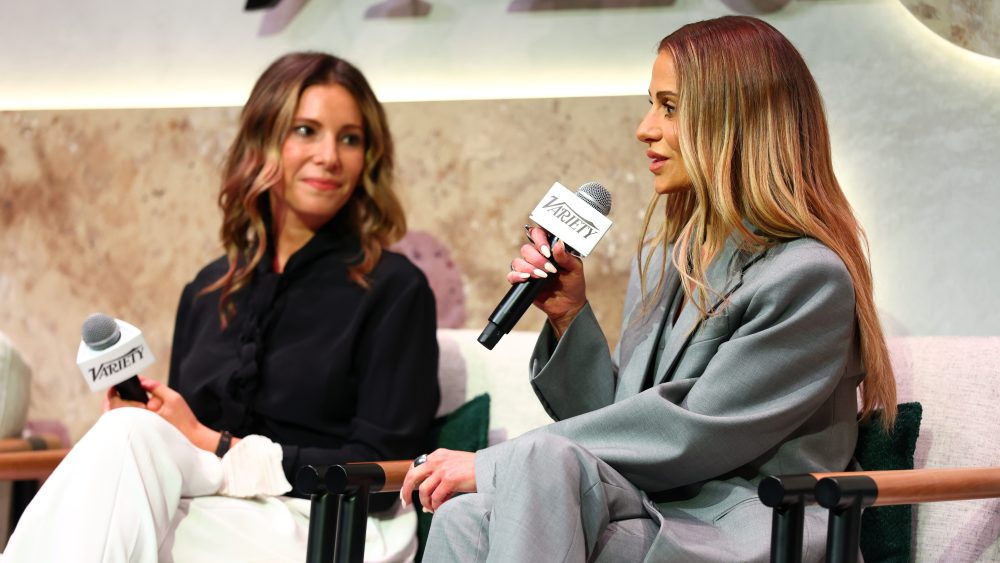Major Takeaways from Variety’s Entertainment Marketing Summit
On Thursday, Variety’s Entertainment Marketing Summit, presented by Deloitte, brought together the top marketing executives across film, television, video gaming and fashion industries. The participants shared insights into their marketing strategies and operations at the event, held at Neuehouse in Hollywood.
There were recurring themes throughout the all-day summit. Several panelists discussed the importance of bringing in existing fandoms, reaching out to younger, Gen Z consumers and the evolution of the relationships between creators and brands.
Read below for major takeaways from the panels.
The Right Stuff – Impact Marketing Roundtable
Darren Abbott, chief brand officer for Hallmark, offered the argument that marketers should move away from placing a heavy emphasis on demographics when trying to reach an audience. “What we’re doing at Hallmark is trying to shift the conversation away from a demographic approach,” Abbott said.
“All of us as marketers and brand leaders need to be thinking about that piece of it. Think about the psychographic profile, think about the people that for us, aspire to a very connected life, that want to put goodness back in the world, and that’s universal, regardless of your age. And so I think all of us need to kind of move away from this sort of myopic view on demographics, and start thinking more about who these people really are and how to have an authentic connection,” Abbott said.
Breaking Through to the New American Consumer
Gayle Troberman, executive marketing advisor at iHeartMedia, spoke with moderator China Widener, vice chair and U.S. technology, media and telecommunications industry leader at Deloitte, about understanding today’s consumers.
Troberman clarified one common misstep that marketers are taking. “Part of the problem is we are targeting our way to oblivion. We are targeting our way to irrelevance, right? We need to talk to more people to sell more stuff, not just people who love Taylor Swift and this kind of shoe…and are really into pop music, right? If Taylor Swift just targeted Swifties, she wouldn’t be Taylor Swift and the Eras Tour wouldn’t have done a billion dollars,” Troberman said.
The Business of Bravo: How Brands Tap into the Bravoverse
Allison Levin, president, advertising and partnerships at NBCUniversal, and Dorit Kemsley, reality star on “The Real Housewives of Beverly Hills,” discussed the success of Bravoverse and engaging with fans through BravoCon.
Levin discussed the popularity of BravoCon, describing how for many fans “BravoCon is actually our Super bowl.”
“One of the stats from the last BravoCon was that 80% of people said, that went to BravoCon, it was the best weekend of their lives, beating their literally, the day they got married and when they had their children,” Levin said.
RELATED CONTENT: Issa Rae and Hoorae Team on ‘Scrappy’ Marketing Plan for Debut Film ‘One of Them Days,’ and If There Will Be a Sequel
That kind of fan support leads to a mix of brand partnerships. “It’s not just fashion brands or beauty brands, which are there and have incredible impacts, but it’s also State Farm and Wayfair, because these are people that are excited to interact with [the fans] in different ways,” Levin added.
From Players to Creators: How Gamers Are Shaping the Creator Economy
Two executives from the company Havas Play, vice president of gaming Jarell Thompson and vice president and portfolio lead Angelique Hernandez, discussed the crucial impact that the video game creators are having in the media marketing sphere.
Hernandez answered a question about the ways conditions have changed for gaming creators.
Creators “have a lot of buying power,” with the ability to get their followers to make purchases but also to exercise “control over their careers.”
“They don’t necessarily have to have a brand partnership, right? They can make money on their own. There are all these platforms now that allow them to do that. You also have companies, whether they’re brands or even social platforms, that turn to them because now, not only are they experts in what their audience likes to see and hear and talk about, they’re also experts on the platform themselves, like creators know how to use Tiktok and Instagram,” Hernandez said.
RELATED CONTENT: ‘The Notebook’ Author Nicholas Sparks Outlines His Rules for Writing Novels: ‘What Are the Ages of the Characters Who Will Fall in Love?’
That power allows creators to be more selective about the brands they partner with, Hernandez said, which ultimately is a win-win for both creators and brands. “You really know that once you pick the creator and that creator picks you back, that’s probably going to be the start of a beautiful relationship that we would want to continue,” she said.
Gen Z Levels Up – Today’s Power Consumer Group
Marketing leaders from e.l.f. Beauty, J.Crew, Hulu, Sony Pictures Entertainment and Blizzard entertainment talked about the consumer base that’s on everyone’s mind: Gen Z.
Monica Austin, Blizzard Entertainment’s chief marketing officer, said that ultimately, the key to understanding Gen Z and how to draw them in is to incorporate Gen Z voices into the company:
“We have to bring them in the room. They are going to shape our brands. They’re going to shape our strategies.”
“We don’t need to, I don’t think, hypothesize about what they’re going to be. They need to help us in this room identify how to reach their generation and beyond. And so it’s really on us to bring them in and not to try to overanalyze,” Austin said.
Embracing AI for Marketing Success
Jenn Lockhart, senior vice president, sales, west coast, at Teads, believes that in order for companies to figure out how to integrate AI into their daily workflow, top leadership needs to embrace AI.
“I think the first place to adopt it is with the leaders as well, because I do think we have to demystify it a little bit,” Lockhart said.
“I’m like, I need to adopt it in my every day, and I need a sticky note that tells me to adopt this in certain ways that help me stick to the strategy and find more efficiency, and then I can bring those to the team. So I do think it starts with us,” Lockhart added.
Master Class in World-Building – The Force of the Entertainment Franchise
Sara Pollack, Pinterest’s global head of consumer marketing, shared a recent example of how Pinterest has tapped into fandoms and created opportunities for them to engage in their passions. At this year’s Coachella, Pinterest partnered with the K-Pop group ENHYPEN. The group created a Pinterest board full of denim aesthetics.
RELATED CONTENT: Marketing Chiefs Say Film and TV Biz Will Hang Tough Amid Recession Fears: ‘We Are the Affordable Pastime’
“Within hours of that board being live, they performed at Coachella, and the entire audience, it was a massive audience for them, was wearing denim. Everybody had literally gone home, back to their hotels, wherever they were, changed into denim because they had sort of picked up on the signal,” Pollack said.
Understanding the Power of Sports Fandom
Jo Fox, senior vice president of marketing at ESPN, discussed ways that ESPN is engaging younger audiences given how their attention is spread across various forms of media. One method is employing a “music strategy” and partnering with artists like Travis Scott.
“It’s not just about talking to them about sport. It’s about culture. What they’re interested in as sports, entertainment, culture becomes even more intersected,” Fox said.
The Anatomy of a Fan Favorite Campaign
Joe Whitmore, executive vice president of global marketing at Sony Pictures Entertainment, discussed rolling out franchise installments and working to keep both existing fans interested while bringing in new fans.
He spoke about the upcoming film, “28 Years Later,” the third in the zombie apocalypse trilogy that began with “28 Days Later” in 2002.
“You have this older, activated fan group that really love it, and then this whole new audience that will be fans, if you can just introduce them to the property in the right way,” Whitmore said.
Whitmore said the trailer was purposefully constructed to make sure fans didn’t feel that the original property was “ruined” but also ensuring that it didn’t reveal too much of the story.
To introduce the franchise to new fans, “we did a feature in Empire Magazine,” Whitmore added.
RELATED CONTENT: Heidi Montag and Spencer Pratt Developing a Hulu Project About Losing Their Home in Pacific Palisades
“You fan the flames on Tiktok, because that’s where everyone fans the flames of fandom nowadays, and now you just walk a tight rope to make sure you don’t ruin the experience for all the new fans that you’ve gotten, the old fans that love the property, and capitalize on that with a really big opening weekend,” he said.
(Pictured: NBCUniversal’s Alison Levin and “Real Housewives of Beverly Hills” star Dorit Kemsley)


